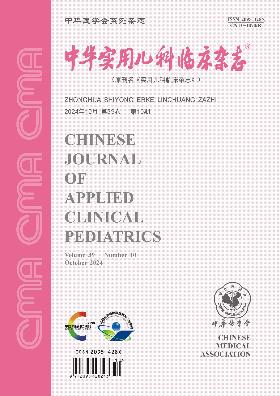儿童典型溶血性尿毒症综合征36例临床分析
Q4 Medicine
引用次数: 0
摘要
目的探讨儿童典型溶血性尿毒症综合征(D+ HUS)的临床表现、辅助检查结果、预后及治疗。方法收集南京金陵医院儿科2001年1月至2019年1月诊断为D+溶血性尿毒综合征的36例患者的临床资料,比较治疗前后血常规、肝肾功能、凝血功能、体液免疫、尿液化验结果。结果白细胞计数((9.28±6.77)×109 / L和(11.20±5.93)×109 / L, c反应蛋白[7.15 (3.34,29.33)mg / L vs.31.83 (25.03, 39.75) mg / L),网织红细胞计数[(112.49±76.25)×109 / L和(206.49±147.99)×109 / L),红细胞沉降[15.02(11.79,22.83)毫米/ 1 h vs.28.06(24.13, 40.52)毫米/ 1 h)、天冬氨酸转氨酶[50.04 (41.92,60.11)U / L vs.62.61 (54.58, 83.52) U / L),丙氨酸转氨酶[16.72 (11.80,24.74)U / L vs.24.54 (20.30, 34.36) U / L),尿酸[(532.84±309.06)μmol/L vs(606.64±327.23)μmol/L]、血清肌酐[160.07(124.87、221.18)μmol/L vs.200.56(160.62、283.01)μmol/L]、血尿素氮[20.74(15.77、28.40)mmol/L vs.33.67(25.91、45.84)mmol/L]、乳酸脱氢酶[488.21(337.59、692.82)U/L vs. 1520.68(734.24、2 272.10)U/L]、凝血酶原时间[(12.14±5.89)s vs(17.91±6.12)s]、活化部分凝血酶时间[(25.05±6.26)s vs(32.38±5.49)s]、纤维蛋白原[(3.79±2.17)g/L vs(5.17±3.88)g/L]、d -二聚体[0.92(0.30,1.13)mg/L vs. 1.27(1.01, 1.90) mg/L]、24小时尿蛋白尿[(84.05±44.19)mg/(kg·24 h) vs.(112.18±78.26)mg/(kg·24 h)]、尿沉渣[175.73(79.72,258.66)×107/L vs. 160.38(118.68, 361.83)×107/L]、n -乙酰基-β- d -氨基葡萄糖苷酶[25.10(18.84,33.02)U/(g·cr) vs. 41.57(29.49, 58.61) U/(g·cr)]、尿视黄醇结合蛋白[0.35(0.18,1.33)mg/L vs. 1.05(0.66, 1.68) mg/L]。],均显著低于治疗前,差异均有统计学意义(P<0.05);治疗后患者红细胞计数[(4.51±1.73)×109/L比(2.43±1.40)×109/L]、血小板[(126.82±78.35)×109/L比(85.21±69.38)×109/L]、血红蛋白[(118.46±18.27)g/L比(62.36±16.11)g/L]、补体c3水平[(0.74±0.39)g/L比(0.58±0.27)g/L]均升高,差异均有统计学意义(均P<0.05)。D+ HUS患儿表现为多系统损伤。其中发热17例(47.22%),腹痛腹泻31例(86.11%),恶心呕吐29例(80.56%),头痛头晕8例(22.22%),蛋白尿、血尿36例(100.00%),肾功能不全34例(94.44%),皮肤及巩膜黄染21例(58.33%)。异常结果的辅助检查主要包括肾脏病理(100.00%)(系膜增生、内皮细胞增生、肿胀、肾小管刷缘脱落)、骨髓病理(100.00%)(骨髓增生活动性)、肾b超(86.67%)(肾损伤样声像)。结论儿童D+ HUS表现为多系统损害。消化系统异常是儿童D+溶血性尿毒综合征的主要致病因素,病情危险。因此,早期诊断和积极治疗可以改善预后。关键词:典型溶血性尿毒症综合征;临床分析;孩子;治疗本文章由计算机程序翻译,如有差异,请以英文原文为准。
Clinical analysis of 36 children with typical hemolytic uremic syndrome
Objective
To investigate the clinical manifestations, auxiliary examination results, prognosis and treatment of children with typical hemolytic uremic syndrome (D+ HUS).
Methods
The clinical data of 36 patients diagnosed as D+ HUS in the Department of Pediatrics of Nanjing Jinling Hospital from January 2001 to January 2019 were collected, and the laboratory results including blood routine, liver and kidney function, coagulation function, humoral immunity and urine were compared before and after treatment.
Results
The white blood cell count[ (9.28±6.77)×109/L vs.(11.20±5.93) ×109/ L ], C-reactive protein [7.15(3.34, 29.33) mg/L vs.31.83(25.03, 39.75) mg/L], reticulocyte count [(112.49±76.25)×109/L vs. (206.49±147.99)×109/L], erythrocyte sedimentation[15.02(11.79, 22.83) mm/1 h vs.28.06(24.13, 40.52) mm/1 h] , aspartate aminotransferase[50.04(41.92, 60.11) U/L vs.62.61(54.58, 83.52) U/L], alanine aminotransferase [16.72(11.80, 24.74) U/L vs.24.54(20.30, 34.36) U/L], uric acid [(532.84±309.06) μmol/L vs.(606.64±327.23) μmol/L], serum creatinine[160.07(124.87, 221.18) μmol/L vs.200.56(160.62, 283.01)μmol/L ], blood urea nitrogen [20.74(15.77, 28.40) mmol/L vs.33.67(25.91, 45.84) mmol/L], lactate dehydrogenase [488.21(337.59, 692.82) U/L vs.1 520.68(734.24, 2 272.10) U/L ], prothrombin time [(12.14±5.89) s vs. (17.91±6.12) s ], activated partial thrombin time [(25.05±6.26) s vs.(32.38±5.49) s], fibrinogen [ (3.79±2.17) g/L vs.(5.17±3.88) g/L], D-dimer [0.92(0.30, 1.13) mg/L vs. 1.27(1.01, 1.90) mg/L ], 24-hour urinary proteinuria [ (84.05±44.19) mg/(kg·24 h) vs.(112.18±78.26) mg/(kg·24 h) ], urinary sediment [175.73(79.72, 258.66)×107/L vs. 160.38(118.68, 361.83)×107/L], N-acetyl-β-D-glucosaminidase [25.10(18.84, 33.02) U/(g·cr) vs. 41.57(29.49, 58.61) U/(g·cr)], urinary retinol binding protein [0.35(0.18, 1.33) mg/L vs 1.05(0.66, 1.68) mg/L.] in patients after treatment were significantly lower than those before treatment, and the differences were all statistically significant(all P<0.05); patients had higher levels of red blood cell count [ (4.51±1.73)×109/L vs.(2.43±1.40) ×109/L], platelet[(126.82±78.35)×109/L vs. (85.21±69.38)×109/L], hemoglobin[(118.46±18.27) g/L vs. (62.36±16.11) g/L], and complement C3levels [(0.74±0.39) g/L vs.(0.58±0.27) g/L ] after treatment, and the differences were all all statistically significant(all P<0.05). Children with D+ HUS showed multiple system injuries.Among 36 cases, 17 cases (47.22%) had fever, 31 cases (86.11%) had abdominal pain and diarrhea, 29 cases (80.56%) had nausea and vomiting, 8 cases (22.22%) had headache and dizziness, 36 cases (100.00%) had proteinuria and hematuria, 34 cases (94.44%) had renal insufficiency, and 21 cases (58.33%) had yellow staining of skin and sclera.The auxiliary examination for abnormal results mainly included renal pathology (100.00%) (mesangial proliferation endothelial cell proliferation and swelling, and shedding of renal tubular brush borders), bone marrow pathology (100.00%) (active bone marrow hyperplasia), and renal B-ultrasound (86.67 %) (kidney injury-like sound image).
Conclusions
D+ HUS in children shows multiple system damage.Digestive system abnormalities are the main causative factor of D+ HUS in children, and the disease is dangerous.Therefore, early diagnosis and active treatment can improve the prognosis.
Key words:
Typical hemolytic uremic syndrome; Clinical analysis; Child; Treatment
求助全文
通过发布文献求助,成功后即可免费获取论文全文。
去求助
来源期刊

中华实用儿科临床杂志
Medicine-Pediatrics, Perinatology and Child Health
CiteScore
0.60
自引率
0.00%
发文量
14243
期刊介绍:
Chinese Journal of Applied Clinical Pediatrics ( semi-monthly ) is a core journal of paediatrics under the supervision of China Association for Science and Technology, sponsored by Chinese Medical Association and undertaken by Xinxiang Medical College. Founded in 1986, it is openly circulated both at home and abroad. The journal has several columns, such as Expert Forum, Experimental Research and Paediatric Surgery, which are mainly for paediatric medical workers and medical researchers in hospitals. Its purpose is to reflect the new theories and technologies in paediatric medicine and scientific research at home and abroad, and to promote academic exchanges.
Chinese Journal of Applied Clinical Pediatrics is a source journal of China Science Citation Database (CSCD), a core journal of Peking University, a source journal of Chinese science and technology paper statistics (China Science and Technology Core Journals), a core academic journal of RCCSE, a high-quality scientific and technical journal of China, a high-quality scientific and technical journal of China Association for Science and Technology, and a high-quality scientific and technical journal of China Biomedical Science and Technology Association. We have been published in China Biomedical Literature Database (SinoMed), China Knowledge Network, Wanfang Data Knowledge Service Platform, China Academic Journal Abstracts, Scopus Database, Chemical Abstracts (USA), Japan Science and Technology Agency (JSTA) Database, Copernicus Abstracts (Poland), Abstracts of the Centre for Agricultural and Biological Sciences (CABS) of the United Kingdom, Cambridge Scientific Abstracts ProQuest Database, WHO Medical Journal of the Western Pacific Region (WMPR), and WHO Medical Journal of the Western Pacific Region (WMPR) of the United States. We have been included in dozens of authoritative databases at home and abroad, such as WHO Western Pacific Region Index of Medicine (WPRIM), Ullrich's Guide to Periodicals, and so on.
 求助内容:
求助内容: 应助结果提醒方式:
应助结果提醒方式:


